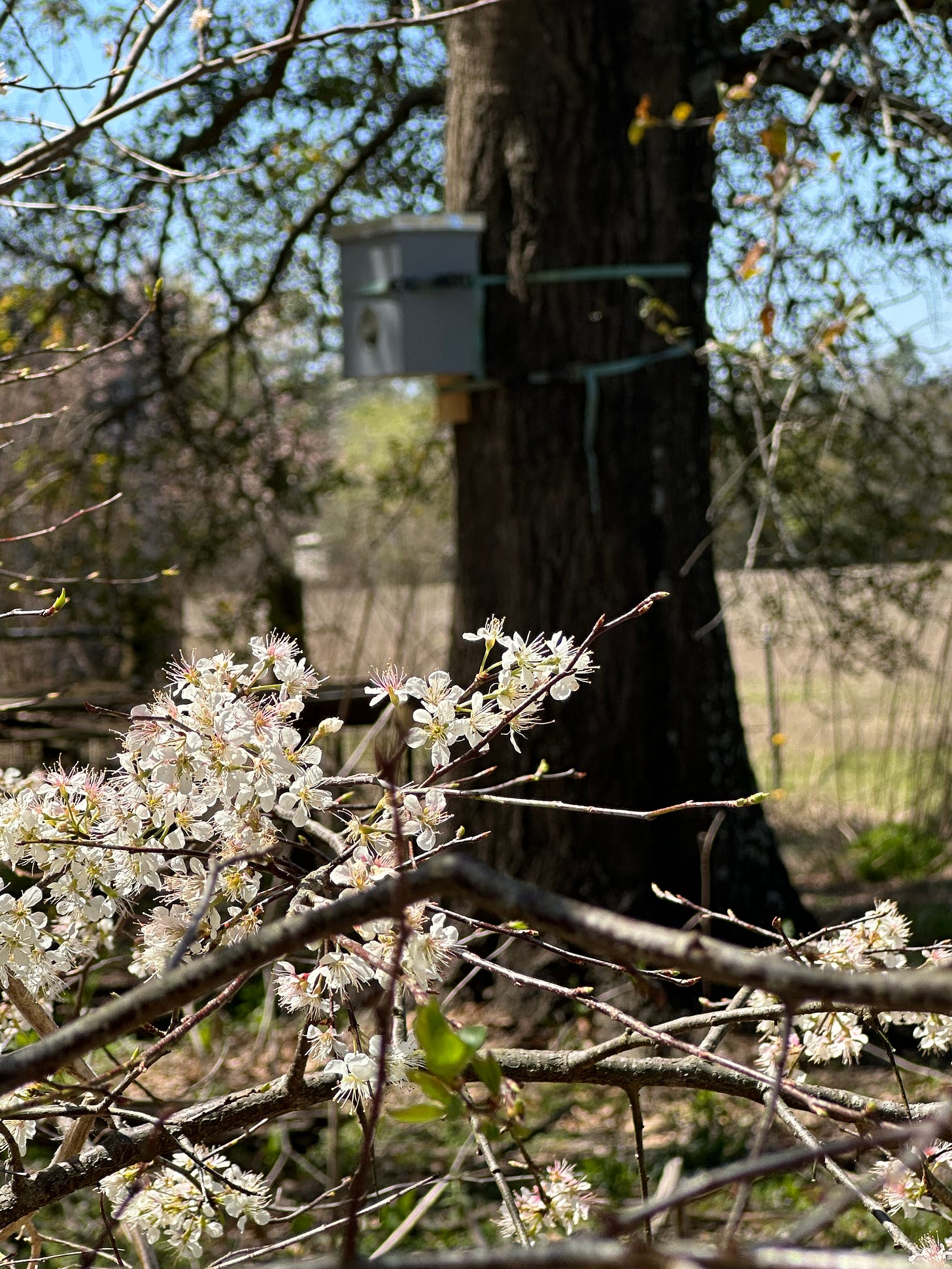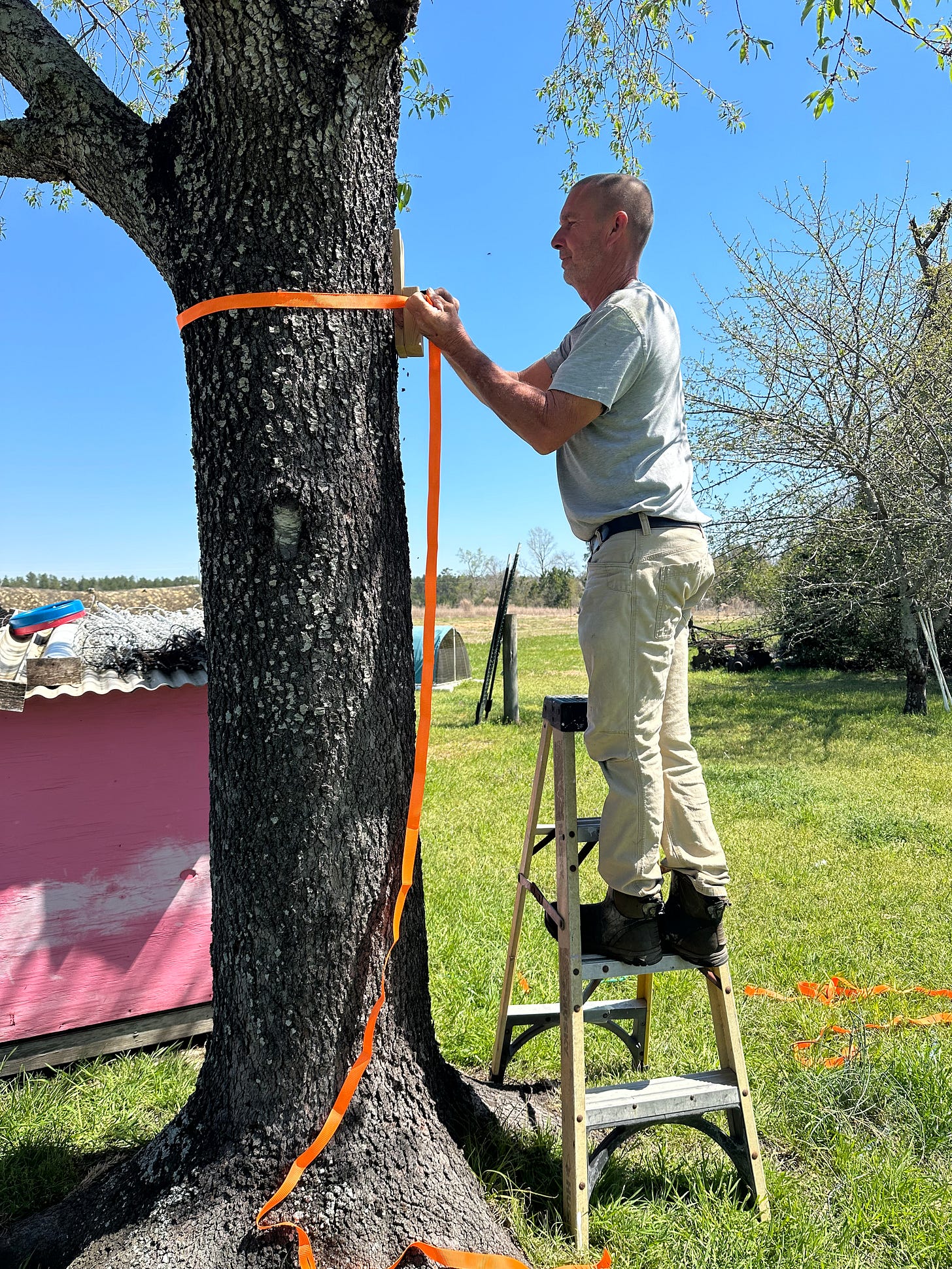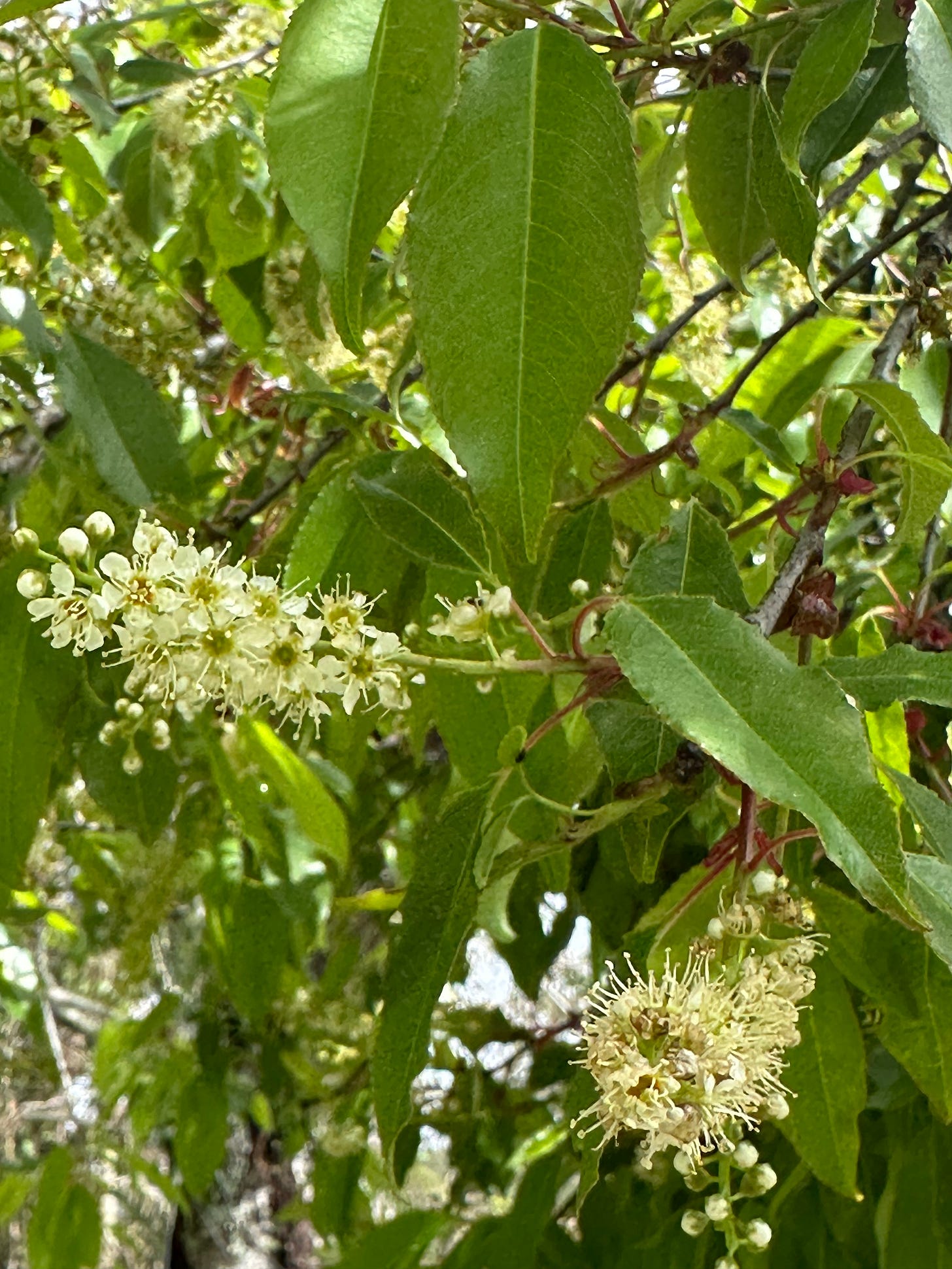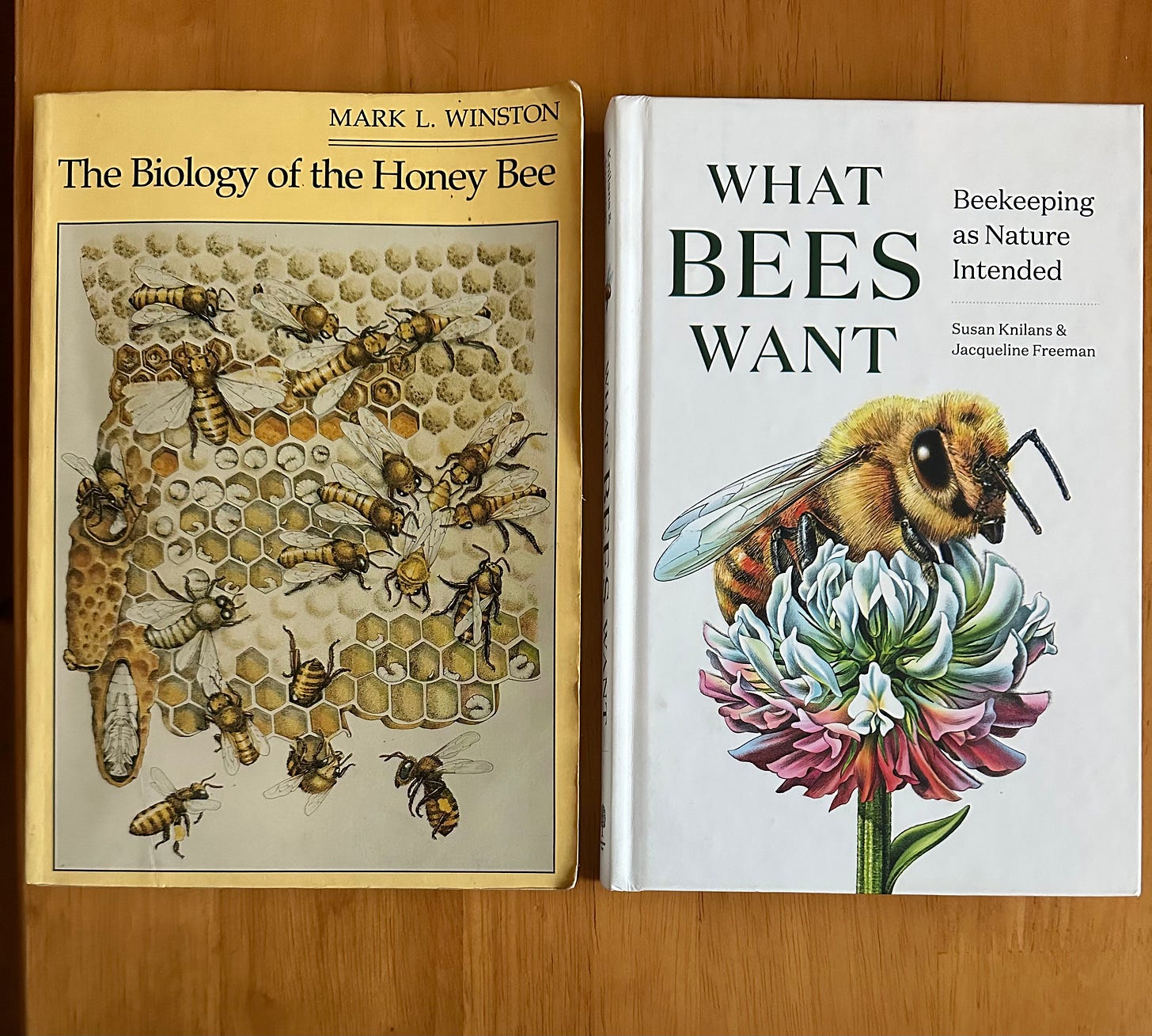March 23, 2025
A Scene
His agile body steps up on the small ladder next to the wild cherry tree. He slings the ratchet strap around the tree and says, “Hey, can you catch the end of that and hand it to me?” I do so, and use an old step in fence post to push the strap further up the tree.
My husband, Ken, and I are hanging our first bee swarm box. As he ratchets down the small block of wood the box will sit on, I feel like it’s a good day to be a bee with the warmth of the golden sun on my back. The scent of the wild plum blossoms wafts on the warm breeze where I imagine they are busily working.
Then I hand him the swarm box that I baited earlier by placing a small ziploc bag inside which holds a paper towel doused with seven drops of lemongrass essential oil. Again, we do the ratchet strap routine. He uses a small level and makes sure the bubble is within the lines horizontally and vertically. We use sticks for shims to get it perfect. I used my iPhone compass to make sure the entrance holes of the swarm traps will face south to southeast and made sure the box is mostly in the shade during the day.
Working on this building project since early February, we’re both excited to get this going. Hanging swarm boxes is much like planting seeds, it’s a hopeful endeavor that requires patience and trust in something beyond what is seen with our naked eye.
Bee-coming
We started working with bees in 2017 and this is the first spring since our disastrous first year that we have no bees. After both of us went back to work off-farm in 2023, we just didn’t have time to do ALL the things required to keep bees in a conventional way. Last year at this time they were spinning off swarms and we were unable to get them to stay in any of the 5-frame nuc boxes we had lying around and those were the swarms we saw when we weren’t at work. Apparently, they all left and then when Hurricane Helene hit, the apiary was blown apart snapping off the heart-rotted wild cherry tree which hung over the area and was the first to bloom every spring. I always said it was from the bee’s magic. As with many things since the storm, it was time to start over and rebuild.
I fell in love with bees and their divine feminine energy when I read the bestselling book by Sue Monk Kidd, The Secret Life of Bees.
Nobody around here had ever seen a lady beekeeper till her. She liked to tell everybody that women made the best beekeepers, 'cause they have a special ability built into them to love creatures that sting. It comes from years of loving children and husbands.
This was long before we came back to live on my family’s farm. I was just a young mother trying to figure out the world when I read that book, but I knew one day, I was destined to live in reciprocity with the bees. I took many lessons from that book-bee lessons and life lessons.
I hadn't been out to the hives before, so to start off she gave me a lesson in what she called 'bee yard etiquette'. She reminded me that the world was really one bee yard, and the same rules work fine in both places. Don't be afraid, as no life-loving bee wants to sting you. Still, don't be an idiot; wear long sleeves and pants. Don't swat. Don't even think about swatting. If you feel angry, whistle. Anger agitates while whistling melts a bee's temper. Act like you know what you're doing, even if you don't. Above all, send the bees love. Every little thing wants to be loved.
We will not just pick back up with vertical-stacking Langstroth hives. They made me dislike beekeeping. Breaking into the bee’s home and shuffling everything around every few weeks made me extremely uncomfortable. I ALWAYS felt like I was doing it wrong and the bees were always mad at me.
In January I listened to a podcast about a more bee-centric way of tending bees which led me to Dr. Leo Sharashkin and his plans for Layens Hives at Horizontal Hive. I convinced my husband to build me 3 extra-deep insulated horizontal Layens hives and 6 swarm boxes. I want to keep wild bees. Bees that are already surviving and thriving throughout the woods in my area. Bees that know the seasonal cycles here and when to expect the blossoms for honey flow and hive expansion and when to contract the size of their colony for winter. The bees from my apiary didn’t die, they left, they went feral. Bees naturally live in trees and have for thousands of years.
Our New Way to Bee
In the spring when everything is in bloom, the bees start flying bringing in pollen and nectar. Bringing it back to the hive for the expanding colony. Once they have filled their space with resources and brood, the queen and worker bees decide it is time to reproduce. Bees reproduce by casting a swarm which generally consists of about half the bees in the hive and the existing queen. They leave behind several queen cups with larva who are fed royal jelly and will hatch as a virgin queen for the existing hive.
The old queen and half the colony go in search of a new home. They may cluster in a nearby tree or structure until scout bees find somewhere suitable for them to go. Hopefully, the scout bees will come across our swarm boxes and find them suitable. They will move in and start building out the 6 frames inside with comb and the queen will start laying eggs. After a couple weeks, we will take down the swarm box and move the new colony to our apiary—more details on this later.
We will be placing three swarm boxes on trees up at the farm and two down in the swamp. Keeping one empty in case we come across a random swarm cluster we may want to catch or to replace one of the swarm boxes we catch a colony in since this would be a tree swarms will return to again and again.
Swarm Box Notes
The boxes were scorched inside to rid them of “new wood” smell. The frames in the boxes have wooden starter strips that were coated with melted beeswax. I also melted some propolis and stuck it in the corners of the boxes like chewing gum. Each hive was baited with seven drops of lemongrass oil on a paper towel that was placed in a ziploc bag which was not quite zipped shut. All of this to make them smell like a nice bee home.
SB#1: Placed 3.23.25 / Moon Cycle: Waning Gibbous / Located about 9’ up on a wild cherry tree near the pasture about 100’ from our previous bee yard. This tree has had many swarms from our apiary in it over the past few years.
SB#2: Placed 3.23.25 / Moon Cycle: Waning Gibbous / Located about 10’ up on a robust live oak tree on the western side of the farm where the pasture meets the Old Woods road.
SB#3: Placed 3.23.25 / Moon Cycle: Waning Gibbous / Located about 12’ up on a live oak tree in the woods on the right side of the Old Woods road where my walking trail makes a roundabout.
Further Reading
If you are interested in getting started with bees, I highly recommend you research as much as possible. Local bee clubs can be helpful but don’t assume their way is the only way to keep bees. At least come to their meetings with your own knowledge base of the different types of hives and ways to keep bees. Contrary to popular opinion in bee clubs I’ve been to…bees can be maintained treatment-free.
Bait Hives for Honey Bees by Thomas D. Seeley
The Biology of the Honey Bee by Mark L. Winston
What Bees Want: Beekeeping as Nature Intended by Susan Knilans and Jacqueline Freeman
Coming up in Part II of this series, I will tell you more of our story with bees, I’ll let you know where we hang the other two swarm boxes, and of course if we catch a swarm here at the farm, I’ll let you know. Until then, let me know what you think about our new way to bee and any encounters you have had with honey bees.
Blessings,
💜B💜
P.S. Any guesses which Swarm Box this is in my nature journal drawing?














What a finely crafted, informative article you wrote! You've had a busy day! It was great to see Ken's outdoor workshop and the turkeys I heard earlier today. The lovely, natural hives must be so enticing to the bee colonies.
I mostly read non-fiction these days, but in decades past, I discovered Sue Monk Kidd's The Secret Life of Bees. Its writing style, mystical themes, and incredible storytelling blew me away. I read several more after that.
I avoided bee-keeping on the farm. We had a neighbor within a mile who raised them. I was so afraid of killing them, and I tried to keep sugar consumption low.
How interesting! I tried my hand at tending European honeybees for three years, but the colony died each year.The second year, they swarmed and I called a beekeeper who would only help capture them if she could take them. I couldn't find a mentor so I followed books and internet advice. Finally gave away my hives and equipment. I love the idea of supporting native bees.